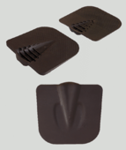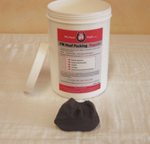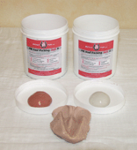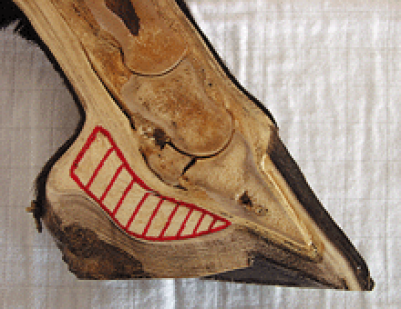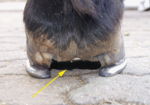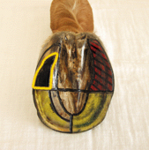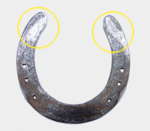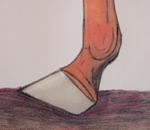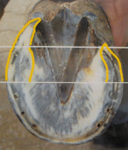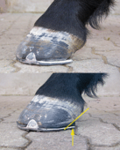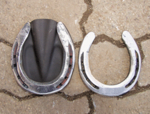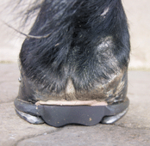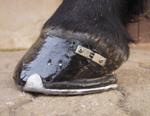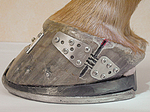PM shoeing system in line with nature
Shoeing with PM pads (either wedge or flat pads 1) and normal or soft PM silicone putty (Photos 2a and 2b) improves stance, optimises load istribution over the hoof, and facilitates the equine foot’s natural functioning. These products offer stable support in locomotion and are excellent in preventing avicular syndrome and hoof problems in general. The navicular bone is vascularised better and not overloaded. Horses with early navicular inflammations immediately walk sound (90% success rate) and can bear loads again. Tension on the heels disappears and crushed heels grow back normally.
Riding in general, whether for competitive sport or recreation, places stress on the horse’s feet, which are the very foundation of balanced locomotion. Nature did not allow for the rider’s weight in “designing” the horse’s limbs. The surplus loads and imbalance created by this additional weight lead to all sorts of problems, including navicular disorders. Such problems are foreign to wild horses. Their hooves wear naturally. The sole is filled by the solar horn and frog, so in the support phase of the stride the hoof’s entire bearing surface actually does bear the horse’s weight. The key element is the hind part of the hoof, under the digital cushion 3. It is a like an intervertebral disc. In the support phase (i.e., weight bearing), the lymph is pumped out of the capillaries and digital cushion, whereas in the swing phase (no weight bearing), the cushion fills up again. Moreover, this ebband-flow effect ensures good blood flow and vascularisation of the tissues, thereby keeping the hoof supple and sound. This is what we call the hoof’s natural pumping mechanism.
It is interesting to realise that the natural hoof spreads almost not at all at the heels, unlike the shod hoof. So the famous “natural” spreading of the hoof is only a belief; it is actually a consequence of being shod and not a natural phenomenon at all. The gap that the shoe creates under the hoof causes the navicular bone, along with the cushion and sole, to drop, and that is why the hoof capsule spreads. Shoes thus hamper the hoof’s natural pumping mechanism, i.e., the ebb-and-flow of fluids created by balanced load distribution, in most horses. The shoe raises the sole and frog off the ground, preventing them from touching the ground 4, and thus eliminates the ebb-and-flow mechanism. All of the animal’s weight comes down first on the small heel area, that is, under the shoe’s heels 5. This weakens many horses’ heels or puts stress on the heels, and because of the hoof’s spreading the heels rub more against the shoe’s hoof surface 6, especially in sandy ground. This gives rise to a long toe that hampers break-over. What is more, the shoe changes the hoof angle as the toe grows out between shoeings, whilst the heels wear down too much, thus exacerbating the problem. To make matters worse, because of the incorrect position that the horse adopts in response to the bothersome shoe, the contact surface with the ground – on which the load presses – becomes more and more out of kilter with the limb. As a result, both the tensions on the deep digital flexor tendon (DDFT) and lever effect on the navicular bone increase.
On soft ground, this lever effect and excessive pressure on the navicular bone occur even when the hoof angle is correct. The space under the weight-bearing hoof causes the hind part of the foot to sink in more 7, precisely at the foot’s centre of gravity, whilst the toe sinks in less. So, the DDFT will be stretched tightly over the navicular bone, which exerts great pressure on the heel itself and on the navicular bone region. This effect is amplified when intense efforts are made during competitions, notably in take-offs and landings for jumpers and in dressage, which makes great demands of the hindquarters.
The PM shoeing system cancels out the disadvantages of the shoe and restores the foot’s natural function and balance. The effect is total when the wedge pad is used with normal or soft silicone. The heels should be trimmed to take the wedge pad into account in order to maintain the right hoof angle. This will enlarge the heels’ bearing surface area greatly 8. First of all, this shifts the hoof’s bearing surface closer to the limb’s bearing axis, thereby improving the limbs’ conformation significantly 9, so that you don’t have to lengthen the shoe’s heels or use trailers. Second, the entire contact surface area increases, thereby ensuring natural, optimal load distribution. That is why shoeing with PM wedge pads can be an effective alternative to a large number of shoeing options 10. The frog-shaped cavity of the PM wedge or flat pad and packing the posterior region of the hoof with normal or soft PM silicone putty restore the frog and sole’s contact with the ground and the ebb-and-flow effect at the same time 11. Once the sole and frog’s natural contact with the ground is restored, the hoof no longer spreads at the heel – which is not a natural phenomenon. What is more, the heels will no longer be subject to abnormal wear, but will grow out correctly. The hoof capsule will grow completely normally and the toe will remain at the correct angle throughout the shoeing interval.
The product must be applied according to precise directions to respect the natural physiology of the hoof. That is possible only if the packing material does not stick to the pad, sole, and frog, unlikely many similar products. Alas, the latter effectively create undesirable tensions as the foot goes through the loading-unloading cycle. PM’s silicone putty – which comes in normal and soft versions – does not stick and thus is perfectly in tune with the hoof’s natural physiology. It offers stability without hampering blood circulation due to excessive rigidity. The patented PM silicone putty is clean and easy to work (you don’t need gloves to shape it) and can also be used in specific places. It is available in two different hardnesses: normal and soft. The soft compound is softer and lighter; it is ideal for very sensitive feet, such as laminitic feet. The various shoes (egg-bar shoes, bar shoes, and shoes with trailers) and pads on the market solve only some of the problems mentioned above, and sometimes create new ones. Egg-bar shoes, for example, improve the limbs’ conformationand reduce the sinking of the hind part of the foot, but increase the pressures that are exerted on the heels and totally prevent the ebband-flow effect. The various pads on the market admittedly prevent the hind part of the foot from collapsing by partly filling the unnatural space that the shoe creates under the sole, but do not increase the contact area in the heel region and thus do not reduce the load on the heels, nor do they improve limb conformation. Some pads with frog supports – they can be found on the market – enable the frog to play its role as a bearing surface, but these pads are not flexible enough and thus eliminate the ebb-and-tide effect. Nor do they enlarge the bearing surface to improve limb conformation and stance. Only when one allows for all the aspects of the foot’s physiology, with balanced pressure distribution, can one say that a shoeing system is preventive or curative. The PM shoeing system has proven effective in 90% of early navicular syndrome cases (tested on 300 horses). This means that the horses were completely cured and no longer showed the slightest sign of lameness. This can be explained medically as well: the ebb-and-flow effect stimulates good tissue irrigation, so enhancing it allows the blood flowThe PM shoeing system has also proven effective in handling hoof cracks, to the extent that cracks inthe heel region are due to the tensions exerted on the plantar edge that are engendered by overloaded heels in the traditionally shod horse. This problem is avoided by using PM pads – flat or wedge pads –, which allow natural load distribution over the sole, frog, and heels in the hind part of the foot. One can also use PM staples 12a/b for added reinforcement. With their special tension-release mechanism, they are the only method in the world that can heal a sandcrack by reconstituting the horn. to carry the inflammatory secretions out of the compartment and clean the injured area.
The PM shoeing system, with wedge pads and soft silicone packing material, has also proven very effective in treating acute laminitis. This system effectively relieves the DDFT and distributes the loads fairly over the bearing surface. Thanks to its great elasticity, the PM soft silicone packing compound absorbs the forces of impact and reduces the number of pressure points on the sole. The PM shoeing system is effective even for horses with spavins, for a foot that is protected in this way offers ideal support for the joints. The system minimises undesirable joint movements. In addition, due to their elevation in the heel region, the PM wedge pads facilitate the limbs’ movements and thus offer more joint relief. A recap of the PM shoeing system’s advantages:
1. Prevention of navicular syndrome through improved limb conformation.
2. Treatment of navicular syndrome through frog support (ebb-and-flow effect) and improved limb
conformation.
3. Natural distribution of pressure over the hoof capsule by enlarging the bearing surface.
4. Regeneration and protection of the heel horn.
5. Correct hoof (toe) angle throughout the shoeing interval.
6. Prevention and treatment of sandcracks through natural pressure distribution.
7. Possibility of correcting the hoof angle with PM wedge pads.
8. Good results in treating spavins and other orthopaedic problems.
9. Treatment of laminitis by packing the bearing surface with PM’s soft silicone putty.


